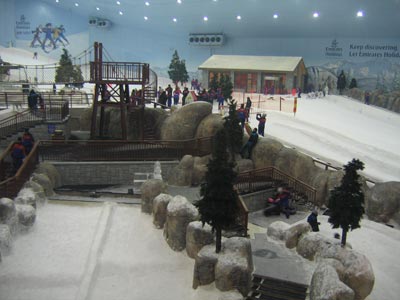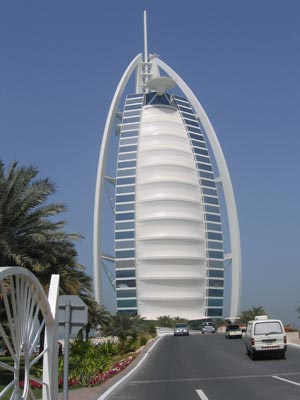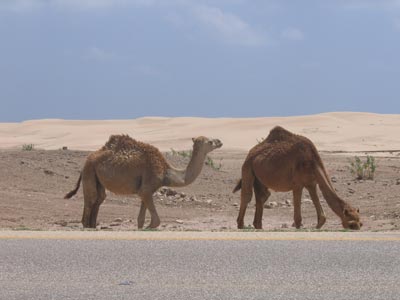Dubai and Oman — Finding glitzy cityscapes, beautiful beaches, and underwater adventure
by Larry Taylor, Fullerton, CA
Before our trip to the Middle East two years ago, we mentioned our plans to our friends and most questioned why on Earth we would go there — terrorists, religious strife and all. In 2007, however, when we said we were going back to this area, flying to Dubai to embark on a cruise, the responses were different. After hearing “Dubai,” their reaction was one of envy. Most had heard about this amazing city and were anxious to see it themselves.
We flew to Dubai in April in order to board a cruise to Alexandria. We decided to fly in a week early and spend a couple days seeing what we could of this fabled city. Then, since we are rabid snorkelers, we decided to go on to Oman, famous for its Indian Ocean diving and snorkeling.
Dubai attractions
Dubai is part of the United Arab Emirates, a confederation of seven emirates, or districts. Abu Dhabi is the largest and Dubai is the most populated, with around a million and a half inhabitants and growing fast.
A boomtown, for sure, Dubai has some 17% of the world’s cranes on construction sites there — mind- blowing, to say the least. Tall and architecturally creative, the nascent buildings thrust up, up and beyond, changing forever the face of this desert landscape.
A Western-friendly tourism destination, Dubai is known for its lavish hotels, lovely beaches and, if you can believe this, an indoor ski slope. Shops there rival the finest in Beverly Hills and Milan. And Universal Studios recently announced plans for a theme park, Universal City Dubailand.
Today, the area’s most famous architectural attraction is the Burj Al Arab hotel. Over a thousand feet high, it was designed after the traditional Middle Eastern dhow, taking the form of a wind-filled sail that appears ready to take off into the sky. It is to Dubai what the Opera House is to Sydney. Architecture buffs come from around the world to see it.
Over the top
Clearly, Dubai is going after the high-end market. The inside of the Burj is beyond lavish, with rooms ranging from $1,000 to $15,000 per night. Among the perks offered are gift bags containing goodies, such as chocolates, fine wines, cake, fruit, dates, nut meats, electric toothbrushes, bottles of perfume (Hermès) and slippers you can take with you, plus two butlers at your service. When you go out to see the city’s sights, a Rolls-Royce is available for transportation.
Offshore, the government is building groups of islands. The Palm Islands contain the three largest artificial islands in the world, each in the shape of a palm frond. Another, called The World, consists of a man-made archipelago of 300 islands forming a world map. With these, around 350 miles of beachfront will be added to the city.
As if this weren’t enough, the world’s tallest building is nearing completion. Its height won’t be revealed until finished.
With the country’s oil running out, the word is that the ruling sheik plans to increase tourist accommodations fourfold by 2020. Dubai strives to be the Las Vegas of the Middle East. (In this Muslim country there is no gambling, of course, but liquor is served in hotels and restaurants.)
Activities and sights
There was so much to see that we barely scratched the surface during our stay. We’re not shoppers, but visiting the Mall of the Emirates, which contains Ski Dubai, is a sight to see, with folks in ski gear coming in from the 90-degree temperature outside to the freezing interior of the cavernous building.
Down the hall, upscale to moderately priced shops selling jewelry, shoes and clothing for men, women and children lined the lengthy center. Men and women, some dressed in traditional garb and some in jeans and Western-style clothing, carried bags from the stores, many of which displayed familiar brands.
Later we strolled Souk Madinat Jumeirah, a colorful, modern market in the tradition of Middle Eastern marketplaces, which offered wide selections of rugs, textiles and brass wares. This souk, unlike those of old, was air-conditioned and ultramodern. What was the same as in the traditional souk were the salespeople in the doorways calling shoppers to come in and bargain for the best prices.
Most interesting was our walk through the Bastakiya district, which took us back in time before the age of electricity and air-conditioning. There we saw numerous wind towers, designed to keep houses cool. We visited traditional homes in which the towers have been retained.
In addition, we took in the Dubai Museum and the nearby historic site of Heritage Village, both located in Old Dubai. They celebrate an era when the area’s commerce was based on pearl diving.
The museum is located in the renovated Al-Fahidi Fort, Dubai’s oldest building, built in 1787 and renovated as a museum in 1970. On exhibit were 4,000-year-old archaeological finds, labeled in both Arabic and English, displayed in air-conditioned comfort.
The Village had displays detailing everyday life through the years, including a re-created tented Bedouin compound. We especially liked the display of artifacts which illustrated the pearl-diving industry back when it was Dubai’s main commercial activity.
We stayed at the Grand Hyatt Dubai (800/233-1234, www.dubai. grand.hyatt.com), a lovely green oasis with lush tropical gardens. The hotel is situated beside Dubai Creek, which runs through the center of town. From our window, we could see dhows carrying goods to market as well as sightseers taking a sail. It lacked the pomp of the Burj, but it was an exceptional hotel with relatively reasonable rates ($460 a night).
On to Oman
After a couple days it was time to take off for Muscat, Oman, about an hour’s flight away or four hours by road. Oman, with its traditional Mideastern look — rugged mountains looming above a desert landscape — was certainly a contrast to glitzy Dubai.
Immaculately clean, Muscat, the capital and a thriving port since ancient times, retains its medieval appearance. With lovely sand-colored architecture, it is the site of the sultan’s main palaces and two medieval forts, Jalali and Mirani, built in the 1580s. Standing imposingly on a hill guarding the city’s entrance, they still are used today by police and the military.
It was well worth the time to take a walk through the Old Town, visiting the Grand Mosque before going on to view Al Alam Palace, an official residence of Sultan Qaboos. Next, we took in Bait Al Zubair Museum to better appreciate Oman’s rich heritage and culture.
Underwater exploration
A year before, we had flown over this part of the world, looking down to see the outlines of reefs close to the shore. We knew snorkeling and diving would be wonderful there.
We contacted the Oman Dive center and, inexpensively ($55 per person), hired a boat operator who took us out along the shoreline 20 minutes from town to a small sheltered cove for some snorkeling. We saw a huge array of fish. Some species we knew; others we had not seen before. The highlight was a porcupine pufferfish about the size of a large cat. We also were intrigued by a very colorful Napoleon wrasse; in other areas the wrasse was just plain gray. All in all, it was a great day at sea.
Salalah
The next morning we left for a one-hour flight to Salalah, at the western end of the country. This area is Oman’s most popular tourist destination. The temperature there is significantly lower than the blazing, more-than-120-degree days of much of the country.
From the coast, it was a short drive to the Smahan Mountains, green with vegetation and much cooler — a sharp contrast to the barren stretches below. Peak season encompasses the monsoon months from late spring through early summer when it rains much of the time. Middle Easterners come to luxuriate in the downpour — a “singin’ in the rain” type of thing.
Salalah also has been, since biblical times, the center of trade for frankincense. Tours take sightseers to visit groves of the fragrant spice trees along the way to the archaeological site of the lost city of Ubar.
Back to the sea
In Salalah, again we headed for the ocean. Through Zahara Tours, we arranged for a driver who also was a diver to take us an hour and a half away to a beautiful rocky coastline with an offshore reef near the small town of Mirbat. Virtually unoccupied except for a few fishermen’s shacks, a postcard-perfect sheltered cove lay before us.
The driver/diver led us out into an aquarium wonderland teeming with sea life — beautiful fish in all colors and sizes. We saw exotic eels, colorful starfish, a small shark and a friendly eagle ray that swam along with us. It was so lovely that we stayed in the warm water for some 90 minutes ($66 per person).
On our way back to the ship, the driver gave us a tour of the countryside, pointing out a waterfall coming down a mountain. Often there were camels roadside, bringing us to a stop as they crossed.
Along the way, we saw an ancient castle and one of the sultan’s three palaces. Although he often stays there, his eminence was not in that day but was out visiting citizens, the driver said, to find out what issues they might have to discuss.
Before we reached the city, we visited a small grove of frankincense trees and extracted a bit of the precious sap, which was pleasingly pungent. The trees, though, were a bit scraggly looking.
The people
Finally, we must say that everyone we ran into in the two countries was friendly and accommodating. Taxi drivers went out of their way to be helpful. Most spoke English well and proudly pointed out city sights. One repeatedly emphasized that he wanted to come to America, still the land of opportunity, for him.
In Dubai we met an Iranian family on holiday. The wives talked about shopping, while us guys discussed playing golf at the nearby Jumeirah Golf Course. It was as if we were talking to our neighbors at home.
The details
For information on Dubai, contact the Department of Tourism (fax +971 4 223 0022, www.dubaitourism.ae). Regarding information on Oman, visit www.destinationoman.com.
For accommodations, we recommend in Muscat the Intercontinental Al Bustan Palace (800/980-6429, www.ichotelsgroup.com). In Salalah, we’d recommend the Crowne Plaza (877/227-6963, www.crowneplaza.com). Both are fine resorts located on attractive beaches.
For watersports and tours, contact Oman Dive center (phone 00968 24485663, www.omandiving.com) or Zahara Tours (968 24400844, www.zaharatours.com).




